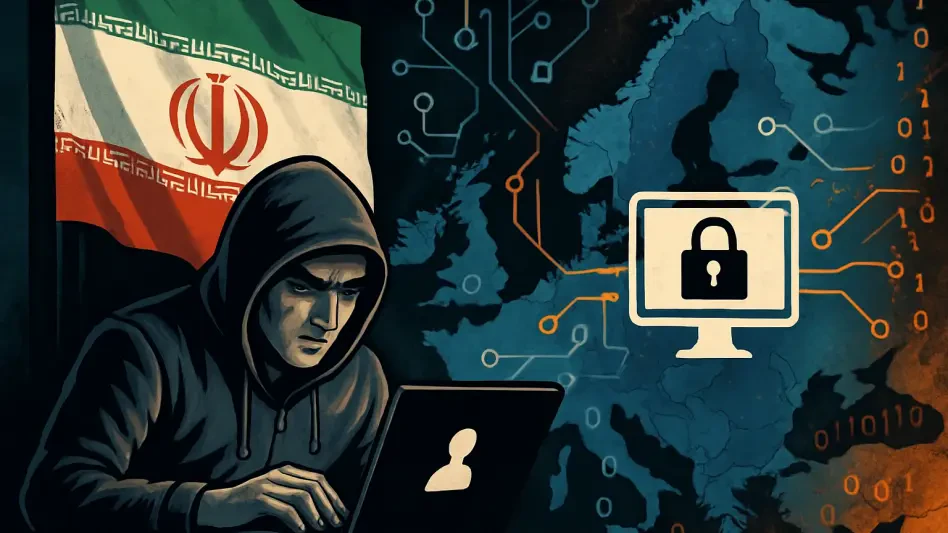In an era where digital threats loom larger than ever, a chilling wave of cyber espionage has emerged from Iran, targeting some of Europe’s most vital sectors with alarming precision and intent to disrupt. Reports from cybersecurity experts have unveiled a sophisticated campaign led by an Iranian hacking group known as Nimbus Manticore, also tracked under aliases like UNC1549 and Smoke Sandstorm. This group has shifted its focus from traditional Middle Eastern targets to critical industries across Europe, including defense, telecommunications, and aerospace. The implications of such attacks are profound, as they aim to siphon off sensitive data that could compromise national security and economic stability in countries like Denmark, Sweden, and Portugal. This alarming expansion signals not just a tactical evolution but a broader geopolitical strategy, raising urgent questions about the vulnerability of global infrastructure to state-sponsored cyber threats.
Unveiling the Tactics of Cyber Espionage
Deceptive Lures Through Social Engineering
The ingenuity of Nimbus Manticore lies in its mastery of social engineering, particularly through the use of fake job offers to ensnare unsuspecting victims. The attack often begins with a seemingly legitimate email inviting targets to apply for positions at well-known companies, directing them to fraudulent websites that mimic giants like Boeing or Airbus. These sites, built with React templates and shielded by Cloudflare to mask their origins, create an illusion of credibility by providing unique login credentials. However, the trap is sprung when victims download a malicious ZIP file disguised as a setup program, which unleashes a complex infection chain. This malware establishes backdoors, enabling attackers to infiltrate systems and extract critical information. Such tactics prey on human trust, exploiting the allure of career opportunities to bypass traditional security measures, and highlight the need for heightened awareness among employees in sensitive sectors.
Evolution of Malicious Tools
Beyond deceptive lures, the technical sophistication of Nimbus Manticore’s arsenal sets it apart as a formidable adversary. Cybersecurity researchers have noted the deployment of advanced malware variants like MiniJunk, an upgraded iteration of the older Minibike, designed to evade modern detection systems with stealthy precision. Another tool, MiniBrowse, focuses on extracting sensitive data such as passwords without triggering alarms. These developments reflect a deliberate effort to refine attack methods, ensuring prolonged access to compromised systems. Additionally, a parallel campaign sees attackers posing as HR recruiters, likely on professional platforms, before shifting to email for spear-phishing attempts. Though simpler, this approach remains effective in targeting specific individuals with access to valuable data. The dual strategy underscores the group’s adaptability, posing a persistent challenge to cybersecurity defenses across Europe’s critical industries.
Geopolitical Context and Strategic Implications
State-Sponsored Motives Behind the Attacks
The operations of Nimbus Manticore are not merely opportunistic but appear deeply intertwined with the strategic objectives of Iran’s Islamic Revolutionary Guard Corps (IRGC). Amid escalating geopolitical tensions, these cyberattacks are believed to serve as a means of intelligence gathering to bolster Iran’s position on the global stage. The shift in focus to European industries marks a significant escalation, reflecting ambitions that extend beyond regional conflicts to impact Western economies and security frameworks. This alignment with state interests suggests a coordinated effort to exploit digital vulnerabilities for political and military advantage. As such, the threat transcends individual organizations, posing a systemic risk to international stability and necessitating a coordinated response from affected nations to counter these espionage efforts effectively.
Building Defenses Against Evolving Threats
As the scope of Nimbus Manticore’s activities broadens, the urgency for robust cybersecurity measures has never been clearer. Experts emphasize proactive strategies, such as intercepting fake emails and malicious files before they reach employees, to mitigate the risk of compromise. Continuous monitoring of the group’s evolving tactics is also critical to anticipate and neutralize future threats. Organizations in vulnerable sectors must prioritize employee training to recognize deceptive lures and implement advanced detection systems to counter sophisticated malware. Looking back, the persistent adaptability of these hackers revealed a stark reality: no industry is immune to their reach. The breaches in Europe’s critical sectors served as a wake-up call, prompting a reevaluation of digital defenses. Moving forward, fostering international collaboration and sharing intelligence on such threats will be essential to safeguard against the insidious nature of state-sponsored cyber espionage.








